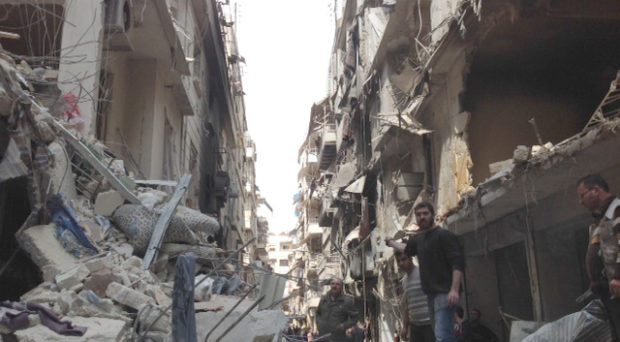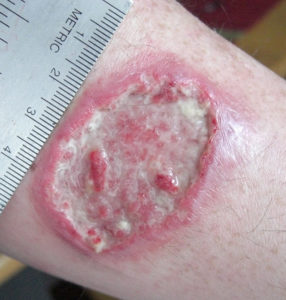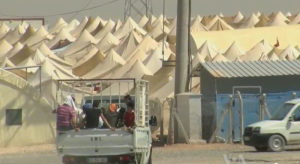
To the left bank of the Qeiq River, the Ancient City of Aleppo stands as a UNESCO world heritage site. Locals and tourists enjoyed freshly brewed Syrian coffee and sugared sweets, taking in the sights of what once was a safe country in the Middle East. It is also home of the ‘Aleppo evil’.
Also referred to as the ‘Aleppo boil’, many that suffer cutaneous leishmaniasis (CL) will certainly consider it an evil or curse. CL is transmitted by the bite of an infected female sandfly which requires a proteinaceous bloodmeal from a living host to develop her eggs. Upon biting, the female deposits parasites within the saliva into the skin. Here the parasites multiply and cause a destruction of tissues, often with disfiguring consequences. Even before the beginning of the conflict, Syria was one of six countries accounting for 90% of all CL cases, with Aleppo itself recording up to 18000 cases per year. The health care system was strong and focused. Notification of the disease was mandatory, and both diagnosis and treatment of CL were provided free of charge. Sand fly programmes were also in place to try and control the spread of the disease.
An overwhelming explosion of cases has spread across Syria and the Middle East. Why?
Following the Arab Spring protests of 2011 and the start of the Syrian Civil War, the chaos that consumed the country wreaked havoc on its health system. As a result of the conflict Syria was divided and with only one part of it under government control many disease control programmes fell apart. Through the forced displacement of millions, transmission hotspots exploded in areas that had not previously reported the disease.
The International Committee of the Red Cross (ICRC), the Syrian Arab Red Crescent (SARC) and Medecins Sans Frontieres are trying to provide aid in areas where hospitals are under constant bombing, despite delivery routes being disrupted.
A news release from the ICRC describes the “devastating and overwhelming” situation in Aleppo: “The past few days have seen water systems, hospitals, warehouses, ambulance stations, public buildings, and civilian homes destroyed or damaged on all sides of the front lines. Patients and medical workers have been killed or injured”. The WHO representative in Syria agreed that people are afraid to visit or even reside near hospitals, out of fear they will be bombed.
The most affected governorates are Damascus, Hasaka, Raqqa, Aleppo, Idlib and Homs, but the situation is constantly evolving and expanding. Over 150,000 cases (25,000 of those being children) of CL have been recorded, however the actual figures are estimated to be much higher due to under-reporting.

Normally, unless secondary infections occur, CL lesions are not usually painful and often self-healing (although it can take several months). Thus, many tend to ignore the lesions feeling ashamed, often hiding them and ultimately- not seeking medical attention until it is too large to conceal. For some, starvation, extreme temperatures and fear of bombshells take precedence over such seemingly ‘superficial’ ailments. For others, it’s simply another scar they will get out of this war.
Treatment
Timely diagnosis and treatment are essential in reducing the risk of disfiguring consequences. Drug shortages in health centres have forced patients to purchase drugs in private pharmacies, where just one of the several injections required for treatment costs an unreasonable 500 Syrian pounds (or USD2.3).
Disease control
Some areas are beginning to implement disease control strategies. Hasaka, a governorate that reported 20000 cases in 2015, has just launched an insecticide spraying campaign which will focus on the areas with the highest case numbers. Hasaka’s health director commented that this only going ahead now (after almost nearly five years of outbreaks), because it has taken that long to gather the necessary numbers of people and equipment to sustain the campaign. Mosquito nets will also be distributed in coordination with the SARC, whose hygiene promotion teams educate communities in how to treat and protect against leishmaniasis during outbreaks. Education remains one of the most important tools for promoting disease awareness and control.
The media
The fundamental role of the media in promoting awareness of leishmaniasis has been invaluable. Until very recently, several news outlets spoke of the ‘flesh-eating disease’ that threatened to overtake the Middle East and Europe. ‘Rotting corpses’ were misreported as the cause of current leishmaniasis outbreaks, leading to the popular belief that leishmaniasis could be transmitted by contact with an infected person. Unfortunately, such thoughts only augment the pre-existing discrimination and stigma surrounding this disease. Additionally, young girls with visible facial scars are no longer considered “suitable” for marriage and have difficulty integrating back into society.
Migration

Millions have fled Syria, now residing in refugee camps in neighboring countries such as Iraq, Jordan, Lebanon and Turkey (amongst many other countries), whilst the remaining population are left displaced in their own country. A growing concern is the potential for the introduction of leishmaniasis into countries where the sandfly vector is already present. Health screening at immigration checkpoints is being explored as a preventative measure against this.

Comments